Rho A Polyclonal Antibody
- Catalog No.:YT4077
- Applications:IF;WB;IHC;ELISA
- Reactivity:Human;Mouse;Rat
- Target:
- Rho A
- Fields:
- >>Ras signaling pathway;>>Rap1 signaling pathway;>>cGMP-PKG signaling pathway;>>cAMP signaling pathway;>>Chemokine signaling pathway;>>Sphingolipid signaling pathway;>>Phospholipase D signaling pathway;>>Endocytosis;>>mTOR signaling pathway;>>Vascular smooth muscle contraction;>>Wnt signaling pathway;>>TGF-beta signaling pathway;>>Axon guidance;>>Focal adhesion;>>Adherens junction;>>Tight junction;>>Platelet activation;>>NOD-like receptor signaling pathway;>>C-type lectin receptor signaling pathway;>>T cell receptor signaling pathway;>>Leukocyte transendothelial migration;>>Neurotrophin signaling pathway;>>Regulation of actin cytoskeleton;>>Oxytocin signaling pathway;>>Parathyroid hormone synthesis, secretion and action;>>Pancreatic secretion;>>Bacterial invasion of epithelial cells;>>Pathogenic Escherichia coli infection;>>Shigellosis;>>Salmonella infection;>>Pertussis;>>Yersinia infection;>>Tuberculosis;>>Human cytomegalovirus infection;>>Pathways in cancer;>>Viral carcinogenesis;>>P
- Gene Name:
- RHOA
- Protein Name:
- Transforming protein RhoA
- Human Gene Id:
- 387
- Human Swiss Prot No:
- P61586
- Mouse Gene Id:
- 11848
- Mouse Swiss Prot No:
- Q9QUI0
- Rat Gene Id:
- 117273
- Rat Swiss Prot No:
- P61589
- Immunogen:
- The antiserum was produced against synthesized peptide derived from human RhoA. AA range:144-193
- Specificity:
- Rho A Polyclonal Antibody detects endogenous levels of Rho A protein.
- Formulation:
- Liquid in PBS containing 50% glycerol, 0.5% BSA and 0.02% sodium azide.
- Source:
- Polyclonal, Rabbit,IgG
- Dilution:
- IF 1:50-200 WB 1:500 - 1:2000. IHC 1:100 - 1:300. ELISA: 1:5000. Not yet tested in other applications.
- Purification:
- The antibody was affinity-purified from rabbit antiserum by affinity-chromatography using epitope-specific immunogen.
- Concentration:
- 1 mg/ml
- Storage Stability:
- -15°C to -25°C/1 year(Do not lower than -25°C)
- Other Name:
- RHOA;ARH12;ARHA;RHO12;Transforming protein RhoA;Rho cDNA clone 12;h12
- Observed Band(KD):
- 22kD
- Background:
- This gene encodes a member of the Rho family of small GTPases, which cycle between inactive GDP-bound and active GTP-bound states and function as molecular switches in signal transduction cascades. Rho proteins promote reorganization of the actin cytoskeleton and regulate cell shape, attachment, and motility. Overexpression of this gene is associated with tumor cell proliferation and metastasis. Multiple alternatively spliced variants have been identified. [provided by RefSeq, Sep 2015],
- Function:
- cofactor:Magnesium.,domain:The basic-rich region is essential for yopT recognition and cleavage.,function:Regulates a signal transduction pathway linking plasma membrane receptors to the assembly of focal adhesions and actin stress fibers. Serves as a target for the yopT cysteine peptidase from Yersinia pestis, vector of the plague, and Yersinia pseudotuberculosis, which causes gastrointestinal disorders. May be an activator of PLCE1. Activated by ARHGEF2, which promotes the exchange of GDP for GTP.,PTM:Cleaved by yopT protease when the cell is infected by some Yersinia pathogens. This removes the lipid attachment, and leads to its displacement from plasma membrane and to subsequent cytoskeleton cleavage.,PTM:Substrate for botulinum ADP-ribosyltransferase.,similarity:Belongs to the small GTPase superfamily. Rho family.,subunit:Interacts with RGNEF (By similarity). Binds PRKCL1, ROCK1 and
- Subcellular Location:
- Cell membrane; Lipid-anchor; Cytoplasmic side. Cytoplasm, cytoskeleton. Cleavage furrow. Cytoplasm, cell cortex . Midbody. Cell projection, lamellipodium . Cell projection, dendrite . Nucleus . Localized to cell-cell contacts in calcium-treated keratinocytes (By similarity). Translocates to the equatorial region before furrow formation in a ECT2-dependent manner. Localizes to the equatorial cell cortex (at the site of the presumptive furrow) in early anaphase in an activated form and in a myosin- and actin-independent manner. .
- Expression:
- Adipose tissue,Brain,Colon,Mammary cancer,Oesophageal carcinoma,Placenta,Re
- June 19-2018
- WESTERN IMMUNOBLOTTING PROTOCOL
- June 19-2018
- IMMUNOHISTOCHEMISTRY-PARAFFIN PROTOCOL
- June 19-2018
- IMMUNOFLUORESCENCE PROTOCOL
- September 08-2020
- FLOW-CYTOMEYRT-PROTOCOL
- May 20-2022
- Cell-Based ELISA│解您多样本WB检测之困扰
- July 13-2018
- CELL-BASED-ELISA-PROTOCOL-FOR-ACETYL-PROTEIN
- July 13-2018
- CELL-BASED-ELISA-PROTOCOL-FOR-PHOSPHO-PROTEIN
- July 13-2018
- Antibody-FAQs
- Products Images
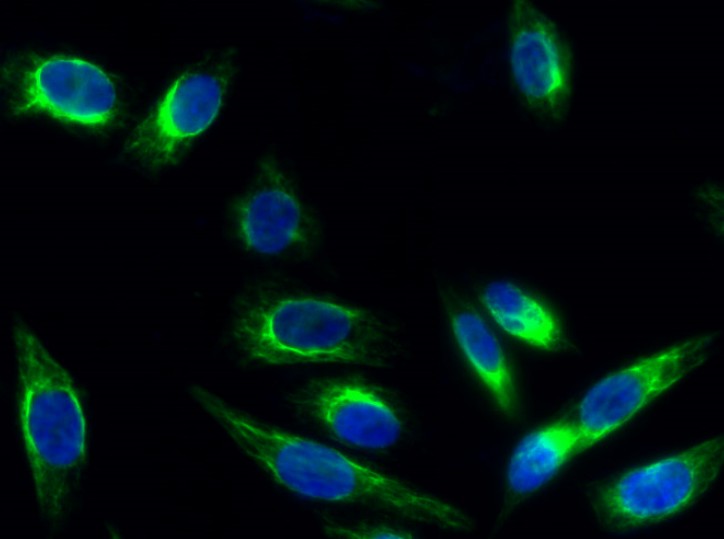
- Immunofluorescence analysis of Hela cell. 1,Rho A Polyclonal Antibody(green) was diluted at 1:200(4° overnight). 2, Goat Anti Rabbit Alexa Fluor 488 Catalog:RS3211 was diluted at 1:1000(room temperature, 50min). 3 DAPI(blue) 10min.
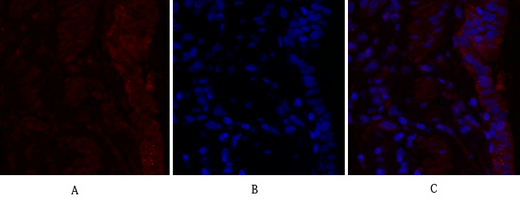
- Immunofluorescence analysis of rat-lung tissue. 1,Rho A Polyclonal Antibody(red) was diluted at 1:200(4°C,overnight). 2, Cy3 labled Secondary antibody was diluted at 1:300(room temperature, 50min).3, Picture B: DAPI(blue) 10min. Picture A:Target. Picture B: DAPI. Picture C: merge of A+B
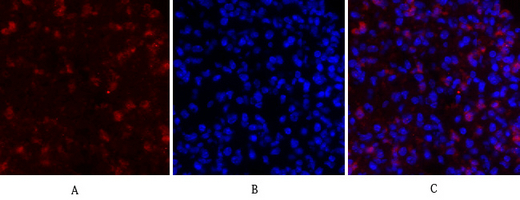
- Immunofluorescence analysis of mouse-lung tissue. 1,Rho A Polyclonal Antibody(red) was diluted at 1:200(4°C,overnight). 2, Cy3 labled Secondary antibody was diluted at 1:300(room temperature, 50min).3, Picture B: DAPI(blue) 10min. Picture A:Target. Picture B: DAPI. Picture C: merge of A+B

- Immunohistochemical analysis of paraffin-embedded Human-stomach-cancer tissue. 1,Rho A Polyclonal Antibody was diluted at 1:200(4°C,overnight). 2, Sodium citrate pH 6.0 was used for antibody retrieval(>98°C,20min). 3,Secondary antibody was diluted at 1:200(room tempeRature, 30min). Negative control was used by secondary antibody only.
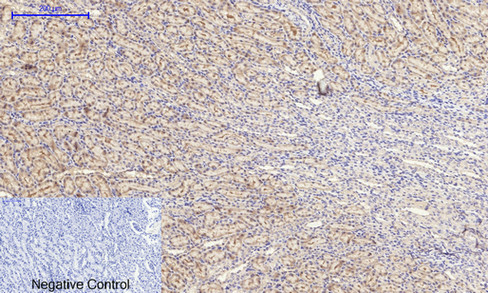
- Immunohistochemical analysis of paraffin-embedded Rat-kidney tissue. 1,Rho A Polyclonal Antibody was diluted at 1:200(4°C,overnight). 2, Sodium citrate pH 6.0 was used for antibody retrieval(>98°C,20min). 3,Secondary antibody was diluted at 1:200(room tempeRature, 30min). Negative control was used by secondary antibody only.
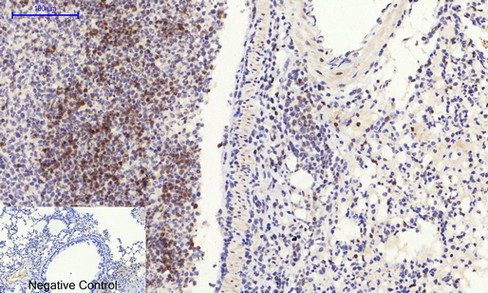
- Immunohistochemical analysis of paraffin-embedded Mouse-lung tissue. 1,Rho A Polyclonal Antibody was diluted at 1:200(4°C,overnight). 2, Sodium citrate pH 6.0 was used for antibody retrieval(>98°C,20min). 3,Secondary antibody was diluted at 1:200(room tempeRature, 30min). Negative control was used by secondary antibody only.
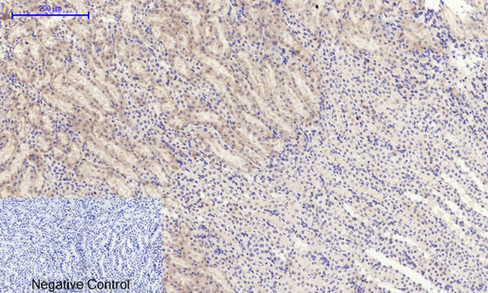
- Immunohistochemical analysis of paraffin-embedded Mouse-kidney tissue. 1,Rho A Polyclonal Antibody was diluted at 1:200(4°C,overnight). 2, Sodium citrate pH 6.0 was used for antibody retrieval(>98°C,20min). 3,Secondary antibody was diluted at 1:200(room tempeRature, 30min). Negative control was used by secondary antibody only.
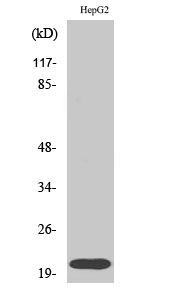
- Western Blot analysis of various cells using Rho A Polyclonal Antibody diluted at 1:500
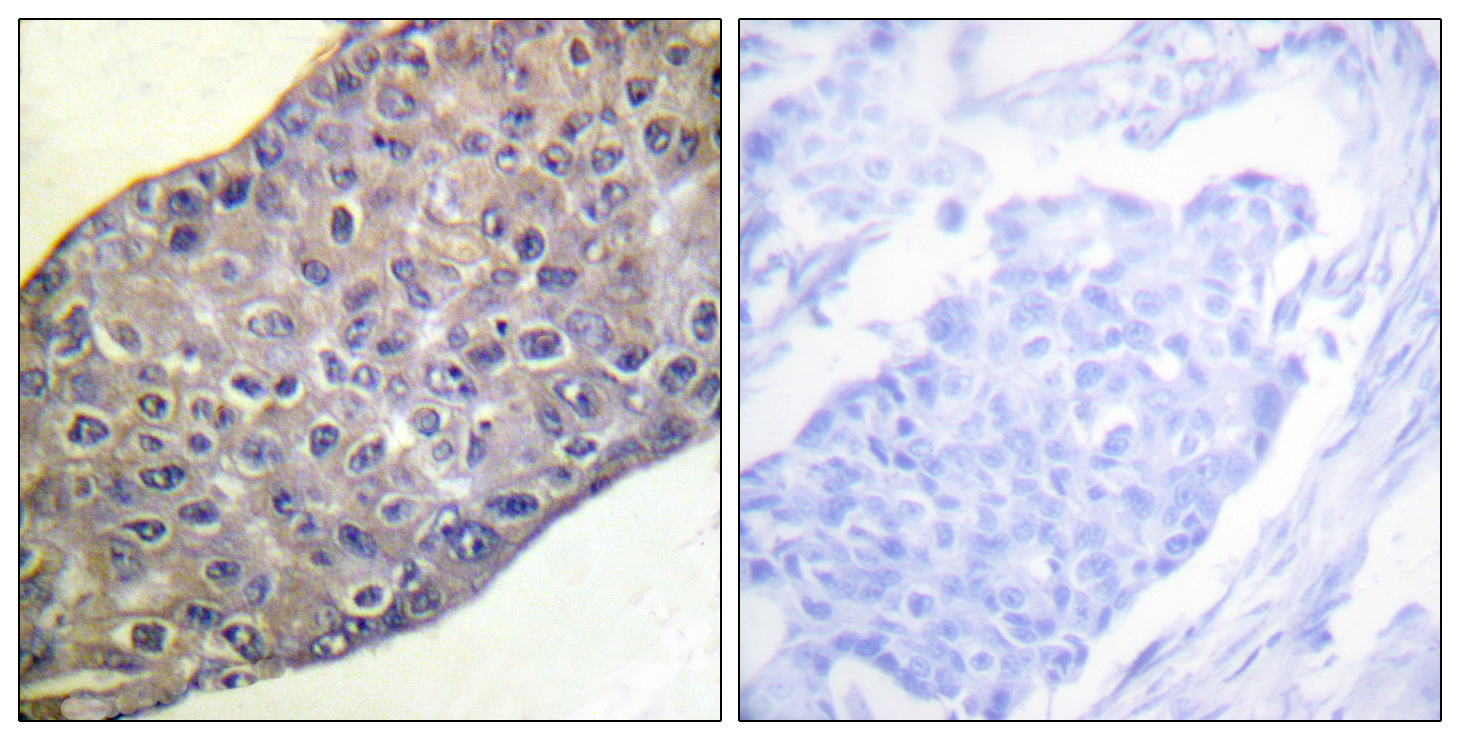
- Immunohistochemistry analysis of paraffin-embedded human breast carcinoma tissue, using RhoA Antibody. The picture on the right is blocked with the synthesized peptide.
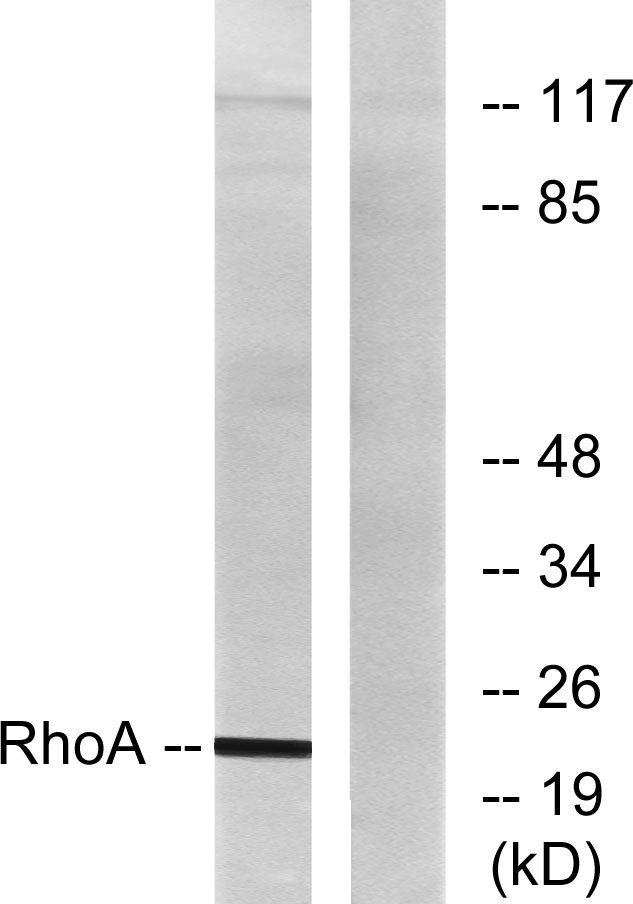
- Western blot analysis of lysates from HepG2 cells, using RhoA Antibody. The lane on the right is blocked with the synthesized peptide.



